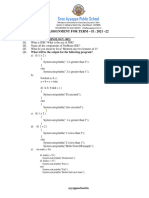0% found this document useful (0 votes)
14 views25 pagesWeek 1
Just assignment for STEP week 1 year 2 which can is not very useful but still if you want it have it
Uploaded by
sauravhang23Copyright
© © All Rights Reserved
We take content rights seriously. If you suspect this is your content, claim it here.
Available Formats
Download as DOCX, PDF, TXT or read online on Scribd
0% found this document useful (0 votes)
14 views25 pagesWeek 1
Just assignment for STEP week 1 year 2 which can is not very useful but still if you want it have it
Uploaded by
sauravhang23Copyright
© © All Rights Reserved
We take content rights seriously. If you suspect this is your content, claim it here.
Available Formats
Download as DOCX, PDF, TXT or read online on Scribd
/ 25





















































































